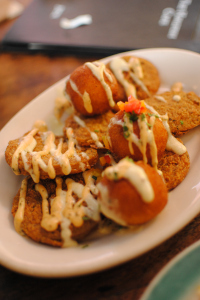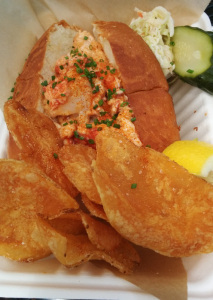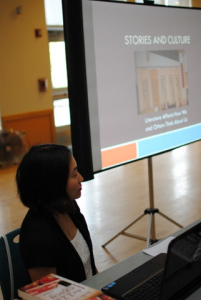Jennifer J. Chow's Blog, page 57
December 8, 2014
Generational Names
“This year your highest priority will be your family.”
My brother and I share a generational name.
Family is important to me, and last week I posted about my baby nephew, along with special foods for new moms. This week I’ll be talking about birth names. I remember searching online and flipping through baby books to choose special English names.
The more difficult task, though, was picking a Chinese name. That required discussion between my husband and me, plus consultation with both sets of parents. This is because a Chinese name has a generational impact. Generational names aren’t whole names passed on to progeny (for example, I’ve known people with III and IV attached to their name). Instead, Chinese generational names involve:
Two characters
The first is the generation name (provided to all siblings, cousins, etc.)
The second is the given name (individual’s unique moniker)
It has significant symbolism (a particular trait or wish for the child)
My own kids start off their names with “purity”
My children use the Chinese characters for their middle names. A lot of my peers and relatives, though, are eschewing the Chinese and giving their kids full English names. (But they may use a Chinese name in private.)
I like having my kids discover tradition in their names. It will give them a unique sense of identity. Also, it makes it easier to claim personalized email addresses and websites in the future. ;)
What name traditions have you encountered?
December 5, 2014
Foodie Friday: Lobster Roll
Had my first lobster roll!
Lobster roll: a creamy lobster sandwich
How can it be that I live near the ocean and never tried a lobster roll before? On a recent trip to Laguna Beach, I stopped by Slapfish to check out the dish. (Slapfish is a great restaurant that uses family-run fisheries and seasonal produce.)
Although lobster rolls originally used meat pickings from the legs and claws, my roll featured large chunks of fresh lobster. I’ve heard the bread used varies across different makers, but mine came out soft and crusty, a perfect complement to the tender seafood.
The sandwich first started in Connecticut during the 1920s, but has since (fortunately) made its way to sunny California. So make your way to a nearby seafood shack. Or create your own lobster roll.
Name your recent food find.
December 1, 2014
30 Days of Herbs
“A new relationship is about to blossom. You will be blessed.”
This Thanksgiving I got to visit my new nephew. The besotted parents were standing nearby, exhausted but beaming. It’s a wonder to hold a newborn. There’s the sweet peach fuzz of hair and the chubby cheeks. The marvel of tiny fingers and toes.
His mother was doing pretty well, considering. She subsisted on a few hours of sleep every day. Luckily, relatives were around to assist. Also, she was placed on a special dietary plan–30 days of herbs. (Traditionally, you’re also supposed to stay inside, rest in bed, and avoid contact with water.) There’s a cultural mandate for a restorative diet after you bear a child. (See my special soups post for a version of sesame chicken soup.)
In some cities, you can hire caretakers who will actually cook the food for you. Others, like myself, have loving parents who make the nutrient-rich dishes. Nowadays, though, there’s even a prepackaged set you can buy–a new daily concoction for the entire first month. Such special foods include:
Chinese angelica root (also known as dang gui; nourishes the blood and improves uterine function)
Dried longan (aids in relaxation and sleep)
Kidney (helps with aches and pains)
Liver (replenishes lost blood)
Pigs’ feet (warms the body and improves lactation)
Wolfberries (nourishes the yin and stops fatigue)
What ways do you know of to nourish a new mom?
November 28, 2014
Foodie Friday: Potstickers
Potstickers: dumplings, often pan-fried
In Chinese, the dumplings are literally called “pot stick.” My mom used to make the filling of potstickers from scratch. She’d pull out our food processor and blend together pork and leeks. Any meat and vegetable combo will work, though.
Some people prefer these dumplings steamed. I’m a big fan of having them pan-fried because I like mine crisp. This requires steaming the potstickers in the beginning, letting the water reduce, and then frying them in the skillet. Here’s a simple recipe for potstickers.
Of course, I use the laziest version of all. I buy mine frozen in bags from the Asian market or even Costco (Ling Ling version). Want some fun facts about potstickers?
Originated during the Song dynasty (960-1280 A.D.)
Legend has it that the imperial chef “invented” the dumplings after burning a batch on the stove
Some Boston area restaurants call them “Peking ravioli”
Do you like potstickers steamed or pan-fried?
November 24, 2014
Book Trailers and Beyond
“Many possibilities are open to you. Take advantage of them.”
The modern world mingles mediums. Take, for example, the book trailer. It’s a visual sneak preview of something that’s written. Admittedly, I personally don’t watch the latest video and then go out and buy a novel. Nevertheless, I’m extremely excited to present the official book trailer for The 228 Legacy:
Go ahead and like it on Youtube! If you enjoyed it, share with your friends.
Beyond book trailers, there are other ways that lines are being blurred across different forms of media, including:
Interactive kids’ books: My friend Romelle Broas has several books out on MeeGenius. The company created one of the first iPad apps for children’s literature. Based on a subscription model, it offers hundreds of books that allow “read-along word highlighting, rich illustrations, and engaging story narration.” Check out Romelle’s cute books, RUNNING BOY, TUMMY MONSTER, and CASEY CHAMELEON on MeeGenius.
Product placement literature: Books may now be involved in commerce. There’s an interesting new venture that incorporates corporate sponsorship. The e-book, FIND ME, I’M YOURS, is formatted through a bunch of websites and web TV shows. It’s got a big protagonist in its story, Sweet’NLow. Read The New York Times post about it here.
Tweetbook: That’s right. You can now tweet your way to book success. The TweetBookz company allows you to gather all your past tweets into one exciting story.
What’s your opinion on combining different mediums?
November 21, 2014
Foodie Friday: Red Bean Cookie
Red bean cookie: pastry-like treat with sweet red bean paste inside

C is for cookie! Around the time I was immersed in Sesame Street, I decided to follow in the footsteps of my favorite blue-furred monster. I cracked open our cookbook to create snickerdoodles. Alas, I wasn’t allowed to use the oven, so I substituted the microwave instead. A shout-out to my brother who tried those rock-hard sweets and even managed to swallow a few pieces without breaking his teeth! Thankfully, I soon learned how to properly make the cookies, and our kitchen was filled with the alluring smells of cinnamon and sugar.
The snickerdoodle is a classic American cookie. What’s a good Chinese one? The red bean cookie. (I’ve indulged in other red bean delights before, like the smoothie and the taiyaki.) The inside of a red bean cookie has a textured taste; the consistency of the bean paste is not quite smooth, and the flavors are layered, with the sugary combined with the fibrous. Red bean, like other legumes, is a powerhouse of nutrients: fiber, protein, and folic acid. Here’s a Hawaiian take on the red bean cookie.
Maybe the red bean cookie can be called nutritious. Kind of like the oatmeal cookie, right? You can justify eating the chewy goodness because certain parts may benefit your body.
What’s your favorite cookie?
November 17, 2014
Does Better English Equal More Pay?
Grammarly (the world’s leading automated grammar checker) recently conducted a study with over 400 freelancers to figure out how English skills affect income. Analyzing data from Elance, Grammarly found that there is a correlation between writing skills and hireability. In simpler terms, better writers tend to make more. Read the Huffington Post article and study the infographic below for further details:
Of course, causation cannot be established, but it makes sense that better communication results in being more valued at work. I’ve had some first-hand experience in seeing how English skills influence jobs. Here are three career-related areas where I’ve seen English make a big difference:
Formatting Resumes:
I used to work in a university’s career office and critiqued resumes for graduating seniors. There’s an art to presenting your work experience. This involves the right amount of white space, along with lining up paragraphs in a neat order. For those who are using a functional resume, it involves highlighting transferable skills that would be attractive to any company.One of the other key elements is the actual writing. I always urged students to write in the active voice. It’s amazing how starting phrases with verbs instills excitement into accomplishments. Precise description also helps in creating vivid imagery (e.g. “supervised 50 employees” and “managed a $800,000 budget”).
Applying for Jobs:
For a time, I also worked at a non-profit. We specialized in job training for low-income women. Some of the participants were looking for their first job, while others were transitioning positions. Before we allowed them into our program, we interviewed each applicant. One of our main requirements was that they had the appropriate language skills. Without adequate English in place, we wouldn’t be able to teach them the skill set to connect them with willing employers.
Busting the English Major Myth:
I always hear about the friend of a friend who majored in English. This poor soul was unable to secure a job for decades. In reality, the people I know who majored in English went on to pretty good jobs. A majority of them are teachers or professors, but others have gone into other productive fields as well.
Do stronger English skills yield better pay? Share your opinion.
November 14, 2014
Foodie Friday First: Fried Green Tomatoes
My first dish of…
Fried green tomatoes: firm tomatoes fried up in a crisp, golden batter

Fried green tomatoes with hushpuppies
This is a Southern favorite, and I tried to make it at home once. Failure. I first wanted to eat it after watching Fried Green Tomatoes. By the way, that’s an excellent movie. It’s got all the elements that I adore: strong relationships between women, a feisty older character, historical references, and a missing man mystery.
I actually watched the movie first, which is a rarity. I tend to read the book and then go chase after the film. Usually, I have a hard time enjoying both a movie and a book. Often, I prefer one over the other (usually the book). In the case of Fried Green Tomatoes (movie) and Fried Green Tomatoes at the Whistle Stop Cafe (book), I loved them equally.
If you can’t have fried green tomatoes at a cafe (author Fannie Flagg modeled the cafe in her book after her great-aunt’s Irondale Cafe in Birmingham), you can go with this recipe.
What’s your favorite Southern food? Any book and movie that you enjoyed equally?
November 10, 2014
Why Do I Write?
“You are never selfish with your advice or your help.”
Last week, I wrote about NaNoWriMo. Apparently, Webucator, the national training company, had the same idea. They had two of their instructors, who are published authors, share about their writing journeys. For this whole November novel-writing month, Webucator is inviting authors to share about their experiences. Here’s my perspective:
What were your goals when you started writing?
I wrote my first story in elementary school. My goal back then was to emulate my favorite authors. The plot was about twins being separated and switched at birth, a prince-and-pauper type of tale.
When I wrote my debut novel, The 228 Legacy, my goal was to share a part of unknown Taiwanese history. I also wanted to pay tribute to family stories I heard about endurance and hope.
What are your goals now?
My goal is still to bring to light new and unique perspectives. My stories are influenced by both my heritage and my professional work with older adults. I’m also interested in exploring social issues, while pushing the envelope in terms of craft.
Assuming writing doesn’t pay the bills, what motivates you to keep writing?
Pay from fiction writing is never consistent. It’s not a lucrative career. Writing, for me, is a passion. It’s about a story that has to be told, that is ready to burst forth from my soul.
Beyond my inner drive, responses from readers also keep me motivated. Whenever people learn about something new, or connect deeply, through my words, it keeps me going.
Finally, what advice would you give young authors hoping to make a career out of writing?
Follow your heart and finish your drafts. The majority of the hard work in writing involves perseverance. It’s difficult to engage in a solitary task, like writing a novel, which takes at least a few months to several years to complete. But have faith in your work and in your voice.
At the same time, I would suggest reaching out to the writing community. Fellow scribes are very supportive and offer a lot of good advice. Connect with others locally and through social media outlets.
In terms of creating a career, I think that involves having a strong body of work. Be in it for the long haul. Juggle multiple ideas at once. I tend to like having my hands in several stories at a time: a draft I’m submitting, another piece I’m editing, and a new story I’m creating.
November 7, 2014
Foodie Friday: Daikon
Daikon: a radish masquerading as a large white carrot

radish soup
Daikon comes from the Japanese words for “big root.” In fact, this radish generally grows up to 18 inches and can weigh about six pounds. The largest ones grown have been around forty to fifty pounds. It’s a mild flavored root, which gives it versatility in different dishes. Although it can be eaten raw, it needs to be cooked once it’s matured. My most common encounter with daikon is in soups, where it’s cooked to melting softness. The root is known for being an immune system booster because it’s full of Vitamin C and displays antiviral properties. Keep a bowl on hand for this cold and flu season!
Fun fact: Besides California, daikon is also commercially grown near Houston, Texas.







